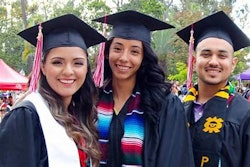WASHINGTON, D.C.
|
| Dr. Margarita Benitez, director of higher education for The Education Trust at the HACU Capitol Forum. |
The National Science Foundation came to Hispanic-serving institutions for advice Sunday on the best way to tackle the dearth of Latinos in the fields of science, technology, engineering and mathematics.
The advice from college administrators gathered for the Hispanic Association of Colleges and Universities’ Capitol Forum came back loud and clear: Pay Hispanic students to do research. Or you’ll never get them – and keep them – in STEM fields.
“Our students are working-class students. They cannot just come to school to do the research. They need to get paid,” said Dr. Mohsen Beheshti, chair of the computer science department at California State University, Dominguez Hills, one of the Hispanic-serving institutions represented at the HACU Capitol Forum this week.
“Sometimes they need to support their parents. Provide them some stipend so they can take time from working – otherwise they will not get in.”
Often, they don’t. Hispanics, who are the largest minority in the country at 14 percent and growing, earned just 7.5 percent of bachelor’s degrees in engineering in 2005, according to a recent report from the National Action Council for Minorities in Engineering. They earned just 7.5 percent of the bachelor’s in biological sciences that year; 6.8 percent in computer sciences; 6.5 percent in physics; and 5.8 percent in mathematics.
Congress in 2007 passed a law that ordered the creation of a National Science Foundation program to improve those numbers at HSIs, where at least 25 percent of the fulltime students are Hispanic. NSF does not have an amount budgeted for the program yet, said Dr. Fae Korsmo, the senior adviser in the NSF director’s office, who gathered the comments at the Madison Hotel in downtown D.C. She told Diverse she expects the program to be put in place by next year or 2011.
But first, came the advice.
“Provide financial assistance, since most of these students come from economically disadvantaged families,” said Dr. Ernest Márquez, a microbiologist who recently retired from the National Institutes of Health and a board member of the Society for the Advancement of Chicanos/Latinos and Native Americans in Science.
“The idea of money has come up again and again because if they have to work and they have to make a choice between school and work, they’ll choose work,” said Dr. David Johnson, director of grants and contracts for math, science and technology initiatives at the National Hispanic University in San Jose, Calif. “That’s just what they do. We have to channel that money that will be supportive of their education rather than detract from it.”
Alejandro Ortíz, a doctoral candidate in psychology from the Pontificate Catholic University of Puerto Rico in Ponce, offered advice from a personal perspective: “Help us pay for graduate school. For example, I have a huge debt. Once I’m out of school, I might not go into research, because I know research doesn’t pay enough to pay my student loans.”
There were other words of advice. Dr. Margarita Benítez, director of higher education for the nonprofit The Education Trust, urged the NSF to look at Latino demographics by state and use those numbers to set a target percentage of Latino students who should be in STEM careers. She lauded the program for targeting Hispanic-serving institutions, particularly community colleges.
|
| Alejandro Ortíz, a PhD candidate in psychology from the Pontificate Catholic University of Puerto Rico in Ponce, speaks to Dr. Fae Korsmo at the Madison Hotel in downtown D.C.. Korsmo is the senior advisor in the National Science Foundation director’s office who was gathering suggestions for a new program to encourage Latinos to join STEM fields. |
“Fifty percent of Hispanics are at HSIs – 55 percent are enrolled at community colleges,” Benítez said. “You know where you need to go to find them.”
Dr. Robert Osegueda, vice president for research at the University of Texas, El Paso, was among several at the session who said the program also needed to promote outreach at K-12 levels to promote STEM careers before they reach college.
But the message on money came through loud and clear to Korsmo and other NSF officials there.
“That was overwhelming,” Korsmo told Diverse. “I heard that. This is the first session to get the dialogue with the community. It will be extremely helpful as we shape the program.”
Email the editor: [email protected]
Click here to post and read comments
© Copyright 2005 by DiverseEducation.com


















